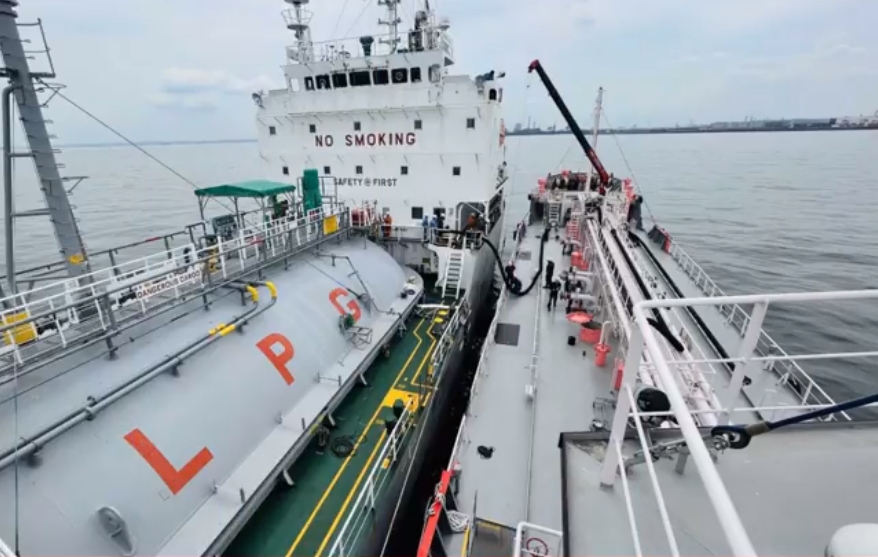Marubeni Corporation (Marubeni), Biofuel technology research Co., Ltd. (BTR) and Tabuchi Kaiun Co., Ltd. (Tabuchi) have jointly brought to fruition an initiative to supply a biofuel for vessels (Biofuel), which is a mixture involving approximately 24% biofuel combined with conventional bunker heavy oil (Very Low Sulphur Fuel Oil; VLSFO).

The Biofuel was manufactured in Japan using technology jointly owned by Marubeni and BTR (Technology). This is the world’s first initiative to fuel a fully-pressurized LPG carrier*1 , the Buena Reina, a vessel operated by Tabuchi and chartered by Marubeni, with such biofuel. The three companies achieved safe navigation*2 of the Buena Reina using the Biofuel with an approximately 19% reduction in CO2 emissions per voyage, leveraging Tabuchi’s various technical know-how in this area.
The Biofuel uses biomass-based waste liquid—a by-product of the production of biodiesel (fatty acid methyl ester) made from waste cooking oil—and green methanol recovered and refined from by-products of wood pulp manufacturing. Through this process, such waste liquid, which would typically come to constitute industrial waste, is thoroughly recycled. In addition, by using green methanol instead of the conventional methanol manufactured from fossil resources, the Biofuel constitutes a recycled complete green fuel*3 which results in virtually no CO2 emissions.

The Keihin area, where the Buena Reina underwent refueling, also boasts the largest scale port in Japan in terms of the volume of cargo handled, and this also represents the first time that an ocean-going vessel has been supplied with a biofuel in this area. Furthermore, as part of the refueling operation on the Buena Reina, the world’s first pure battery tanker Asahi, a vessel operated by Asahi Tanker Co., Ltd., which uses renewable energy and was chartered by Marubeni, also achieved zero emissions of greenhouse gases (GHG emissions) during bunkering.
The International Maritime Organization (IMO) has set a goal for the international shipping industry of halving GHG emissions by 2050 when compared to 2008 levels, and Japan is also aiming to achieve carbon neutrality by 2050. Various measures are additionally being considered to reduce GHG emissions in response to the CII Fuel Efficiency Performance System*4 , which came into effect this year. There is particular expectation that biofuels will expand supply volumes as one of the effective measures to reduce GHG emissions. Marubeni and BTR will promote domestic and international sales of the Technology and propose the use of green methanol and low carbon emission methanol*5 procured by Marubeni.
Marubeni and Tabuchi will meanwhile explore the use of sustainable biofuels. Going forward, the three companies will utilize their respective insights and know-how to incorporate various methods facilitating the reduction of GHG emissions, including CO2, while promoting and exploring initiatives to contribute to the reduction of environmental impacts. In addition, as was the case during this initiative, Marubeni will cooperate with stakeholders in various industries to provide highly sustainable services catering to various customer needs, such as low-carbon and decarbonization processes.
* 1A carrier that transports liquified gas products at normal temperatures by applying pressure to their cargos.
* 2 The propylene loaded on the Buena Reina was sold to Zhejiang Sanyuan Petrochemical Co., Ltd. (hereinafter, “Sanyuan”), a major polypropylene manufacturer in China, with Sanyuan covering the costs of this initiative.
* 3Recycling and regenerating industrial waste and synthesizing it with green methanol makes the process even more environmentally friendly and facilitates further reductions in GHG emissions than is the case with standard biofuels.
* 4 Carbon Intensity Indicator, a rating system for fuel efficiency performance. The CII system was adopted by the IMO as a framework to promote improvements in fuel efficiency in the entire international shipping industry by rating ships based on their annual fuel efficiency. The framework requires reductions in the CII values compared to the average CII value for each ship type in 2019, of 5% by 2023, 7% by 2024, 9% by 2025, and 11% by 2026, and subsequent yearly improvements of reduction rates. The IMO also encourages all shipping stakeholders, including charterers, ports, insurance companies, financial institutions, and maritime pilots, to incentivize ships with a high CII rating.
* 5 Methanol with low environmental impacts, such as that classified as CCU (Carbon dioxide Capture and Utilization), manufactured using captured CO2 and hydrogen as raw materials. The origin of carbon in methanol differs from methanol produced from fossil fuels.